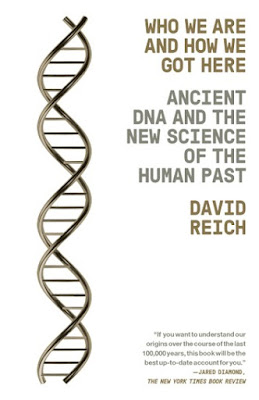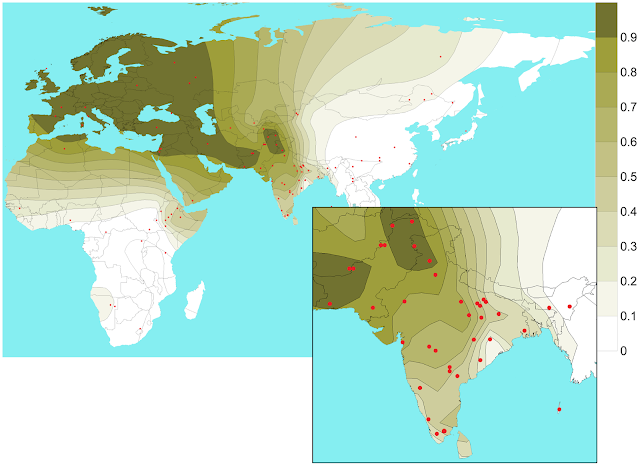PakAlumni Worldwide: The Global Social Network
The Global Social Network
Harvard Scientist Debunks Hindu Nationalists "Racial Purity" Myth
Male ancestors of the vast majority of present-day South Asians (Indians, Pakistanis, Bangladeshis) came from West Eurasia, Central Asia and Iran, according to the latest DNA research led by Harvard geneticist Dr. David Reich. Reich's team came to this conclusion after studying the Y-chromosomes of present-day Indians. Some Hindu Indian scientists have used mitochondrial DNA (mtDNA) samples, extracted from the bones of recently discovered ancient skeletal remains of a couple in Rakigarhi in Haryana, to claim the local indigenous origins of all Hindus. Y-chromosomes are passed from father to son while mitochondrial DNA is passed from mother to children. The Harvard team's findings thoroughly debunk Hindu Nationalists' "racial purity" myth similar to that promoted by White Supremacist racists in the West. Reich writes: "The Hindutva ideology that there was no major contribution to Indian culture from migrants from outside South Asia is undermined by the fact that approximately half of the ancestry of Indians today is derived from multiple waves of mass migration from Iran and the Eurasian steppe within the last five thousand years".
 |
| David Reich's "Who We Are" |
Reich's Indian counterparts were highly resistant to the Harvard team findings of foreign origins of modern-day South Asians. Here's an excerpt from David Reich's "Who We Are and How We Got Here":
"Based on their own mitochondrial DNA studies, it was clear to them (Indians) that the great majority of mitochondrial DNA lineages present in India today had resided in the subcontinent for many tens of thousands of years.They did not want to be part of a study that suggested a major West Eurasian incursion into India without being absolutely certain as to how the whole-genome data could be reconciled with their mitochondrial DNA findings. They also implied that the suggestion of a migration from West Eurasia would be politically explosive. They did not explicitly say this, but it had obvious overtones of the idea that migration from outside India had a transformative effect on the (South Asian) subcontinent".
"To keep up the purity of the Race and its culture, Germany shocked the world by her purging the country of the Semitic races -- the Jews. Race pride at its highest has been manifested here. Germany has also shown how well-nigh impossible it is for races and cultures, having differences going to the root, to be assimilated into one united whole, a good lesson for us in Hindusthan to learn and profit by."
"Groups of traditionally higher social status in the Indian caste system typically have a higher proportion of ANI ancestry than those of traditionally lower social status, even within the same state of India where everyone speaks the same language. For example, Brahmins, the priestly caste, tend to have more ANI ancestry than the groups they live among, even those speaking the same language. Although there are groups in India that are exceptions to these patterns, including well-documented cases where whole groups have shifted social status, the findings are statistically clear, and suggest that the ANI-ASI mixture in ancient India occurred in the context of social stratification".
 |
| South Asian Ancestry. Source: Arain Gang |
 |
| 1901 Indian Census of UP Muslims |
 |
| Light Skin Gene Distribution. Source: PLOS Genetics |
 |
| 1901 India Census UP Hindu Population By Castes |
World Values Survey Finds Indians Most Racist
Indians Admire Israel and Hitler
Caste Apartheid in India
Religion, Caste and Politics in India by Christophe Jaffrelot
Mahatma Gandhi and His Struggle With India
Who Killed Karkare?
Procrastinating on Hindutva Terror
India's Guantanamos and Abu Ghraibs
Hindutva Government in Israeli Exile?
Growing US-India Military Ties Worry Pakistan
The 21st Century Challenges For Resurgent India
-
Comment by Riaz Haq 14 hours ago
-
The Western Steppe Herders and the Formation of South Asian Ancestry
This map visualizes the main ancestral components of South Asian populations as modeled through Genoplot and Global25, highlighting the genetic impact of the Western Steppe Herders (WSH) contribution, the population associated with Bronze Age expansions from the Pontic–Caspian steppe (ca. 3000–1500 BCE).
The WSH component (light blue) represents the genetic legacy of the pastoralist societies connected with the Yamnaya and later Sintashta–Andronovo cultures, whose migrations profoundly reshaped the genetic and linguistic landscape of Eurasia. In South Asia, this ancestry entered the subcontinent around the mid-second millennium BCE, merging with pre-existing Neolithic and indigenous groups.
Its highest frequencies are observed among northern Indo-Aryan populations, notably in Punjab, Haryana, Kashmir, and parts of Uttar Pradesh, correlating closely with the historical diffusion of Indo-European (Indo-Aryan) languages and with Y-chromosome haplogroup R1a-Z93. The genetic signal diminishes gradually toward the Dravidian south and the Austroasiatic east, where AASI and Neolithic Iranian ancestries predominate.
This pattern indicates a north-to-south cline formed through male-biased gene flow, consistent with the arrival of steppe pastoralist groups who intermingled with established farming and hunter-gatherer populations. The interaction between the WSH, Neolithic Iranian, and AASI components produced the distinctive genomic structure of modern South Asians, reflecting a synthesis of steppe, Near Eastern, and indigenous South Asian lineages that continues to define the region’s diversity today.
Comment
- ‹ Previous
- 1
- 2
- 3
- 4
- Next ›
Twitter Feed
Live Traffic Feed
Sponsored Links
South Asia Investor Review
Investor Information Blog
Haq's Musings
Riaz Haq's Current Affairs Blog
Please Bookmark This Page!
Blog Posts
Improved US-Pakistan Ties: F-1 Visas For Pakistani Students Soaring
The F-1 visas for Pakistani students are soaring amid a global decline, according to the US government data. The US visas granted to Pakistani students climbed 44.3% in the first half of Fiscal Year 2025 (October 2024 to March 2025) with warming relations between the governments of the two countries. The number of visas granted to Indian students declined 44.5%, compared to 20% fewer US visas given to students globally in this period. The number of US visas granted to Pakistani…
ContinuePosted by Riaz Haq on October 19, 2025 at 10:00am — 1 Comment
Major Hindu American Group Distances Itself From Modi's India
"We are not proxies for India in the US", wrote Suhag Shukla, co-founder and executive director of the Hindu American Foundation (HAF) in a recent article for The Print, an Indian media outlet. This was written in response to Indian diplomat-politician Shashi Tharoor's criticism that the Indian-American diaspora was largely silent on the Trump administration policies hurting India. …
ContinuePosted by Riaz Haq on October 11, 2025 at 2:00pm
© 2025 Created by Riaz Haq.
Powered by
![]()
You need to be a member of PakAlumni Worldwide: The Global Social Network to add comments!
Join PakAlumni Worldwide: The Global Social Network